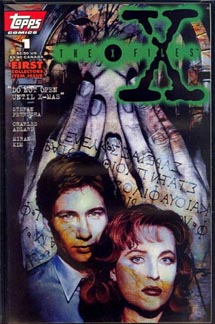“The X-Files” has only produced six original novels and one short-story collection to date, but it has enjoyed a more robust life in the realm of comics, starting with a 41-issue (and plenty of specials) run with Topps Comics from 1995-98. At first blush, this is odd, because it seems like a show dependent on mood and nuances would play better in books than comics. But as Topps’ Issues 1-12 (1995) demonstrate, Chris Carter’s program translates better to the four-color art form, at least under the guidance of writer Stefan Petrucha.
On his “X-Files Files” podcast, Kumail Nanjiani noted that he has been reading the Topps comics (as recently reprinted by IDW) and found them to be a fascinating alternate timeline, with a different conspiracy than is found on the series proper. This is a fair assessment, but I’m the type who likes to fit all stories in a franchise into one continuity if possible. Certainly, it’s safe to say that Petrucha didn’t feel he was creating an alternate “X-Files.” He references events from the show regularly – Mulder accesses memories of his sister’s abduction and Mrs. Scully reminds her amnesiac daughter about her father’s death a year earlier in Season 1’s “Beyond the Sea.” (These 12 issues take place in real time, parallel to the end of Season 2 and the start of Season 3.)
By the end of these dozen issues, the implication is clear that Petrucha’s sinister cabal (or “inner government,” as he often calls it) – known as Aquarius — is a subgroup of the TV show’s Syndicate. Aquarius — led by General Schadenfreude and featuring agents known as Blue, Black, Grey and so forth, like in “Reservoir Dogs” – is more overtly aggressive than the Syndicate proper, showing up at nearly every one of the cases Mulder and Scully investigate. Aquarius often wants to acquire the same artifact Mulder is after, and the group has no problem with the idea of killing the agents.
In Issues 4-6 (the “Firebird” trilogy – “Khobka’s Lament,” “Crescit Eundo” and “A Brief Authority”), the Aquarius agents are particularly ubiquitous, which raises the question of how they can likewise remain so secret. A liberal policy of killing people who learn about them – or using memory-erasing gas, as in the Kansas UFO incident — could explain some of it, but the problem with big conspiracies is you need both a large group and a loyal group; as such, Aquarius has less verisimilitude than the wider Syndicate.
Despite the slight misstep of having Aquarius be too in-your-face, these comics are better than I remember, and more consistently good than IDW’s current run (although I’ll give those another chance on a re-read, too). Petrucha is a rabid researcher who provides a works cited list on each issue’s letters page. His artifacts are suitably compelling, starting with the Fatima Prophecy in Issue 1 (“Don’t Open Until X-Mas”), which is sort of a Pandora’s Box – it features answers to life’s mysteries so profound that supposedly no human is prepared to read it. In a scene that serves as a tidy metaphor for “The X-Files” as a whole, Mulder has his hands on the parchment on the final panel, only to be surrounded by gun-toting Aquarius members, who take it from him.

The ultimate artifact of the opening 12 issues is a crystal skull (like in the fourth “Indiana Jones” movie) that perhaps allows communication with an alien race that perhaps served as mentors to the Aztecs. I found the denouement in Issue 12 (“Nightmare of History,” wrapping up the “Feelings of Unreality” trilogy) confusing, but on the other hand, I loved the opening sequence wherein Mulder takes down the conspirators in a court of law. It builds up to the revelation of his key exhibit, “the body of an alien-human hybrid!” It’s all a dream, but Petrucha and artist Charles Adlard earn the trickery with their (in retrospect) unlikely touches such as the Cigarette-Smoking Man puffing away at the defendants’ table and the Lone Gunmen being seated in the audience. The revelation is the ultimate clue that it’s all a dream, as the comics hadn’t explored alien-human hybrids like the parent show had.
I had remembered that a lot of the Topps Comics stories felt truncated compared to the show, but that’s not the case, at least not in this 1995 batch. Sometimes, Petrucha fits a fully formed story into one issue (Issue 1, for example); other times it takes more issues. Issues 2 and 3, “A Dismembrance of Things Past” and “A Little Dream of Me,” feel like a mythology two-parter wherein M&S visit a Kansas town that was essentially a second Roswell and end up with their memories partially wiped. Generally, one issue feels like one TV episode in these Topps comics, a formula that can’t be relied upon with the new IDW comics, where each issue generally contains less story.
The comics arguably get darker than the TV series ever did in Issues 8 and 9 (“Silent Cities of the Mind, Parts 1 and 2”), about a cannibal who acquires the knowledge of the people he eats. Petrucha’s ability to get creative with history is in fine form here, as he imagines that the Aztecs came across the land bridge from Asia, but didn’t go directly to Mexico. Instead, some of them settled in Alaska. Along with Season 1’s “Ice” and Wildstorm’s “X-Files”/”30 Days of Night” crossover, the Last Frontier is a reliably foreboding setting for a great X-File.
In addition to being daring with his set-pieces (an abandoned ancient underground city in Alaska, for example), Petrucha – whose work is accented by Adlard, who draws excellent Mulder and Scully likenesses without sacrificing the mood – dares to put the characters through their paces. Issue 7 (“Trepanning Opera”) is particularly tasty, as it chronicles a rogue FBI agent who believes he can see the future through a “third eye” in the middle of his forehead. Tapping into Philip K. Dickian ideas about the nature of reality, the story suggests that although it seems Scully survives at the end, she “may only be imagining that (she) survived.” The “Scanner Darkly”-style yarn becomes extra intriguing given the TV show’s controversial but fascinating mythology element that Scully might be destined to live forever (as per “Clyde Bruckman’s Final Repose” and “Tithonus”).
Whether the Topps comics are truly part of the “X-Files” mythos or merely a side trip of “what ifs?” is a fair question, and I suspect most fans would say they are not part of the true canon. Nonetheless, they are undeniably intriguing yarns, and at this point in my re-read, I recommend them to fans of the show.

